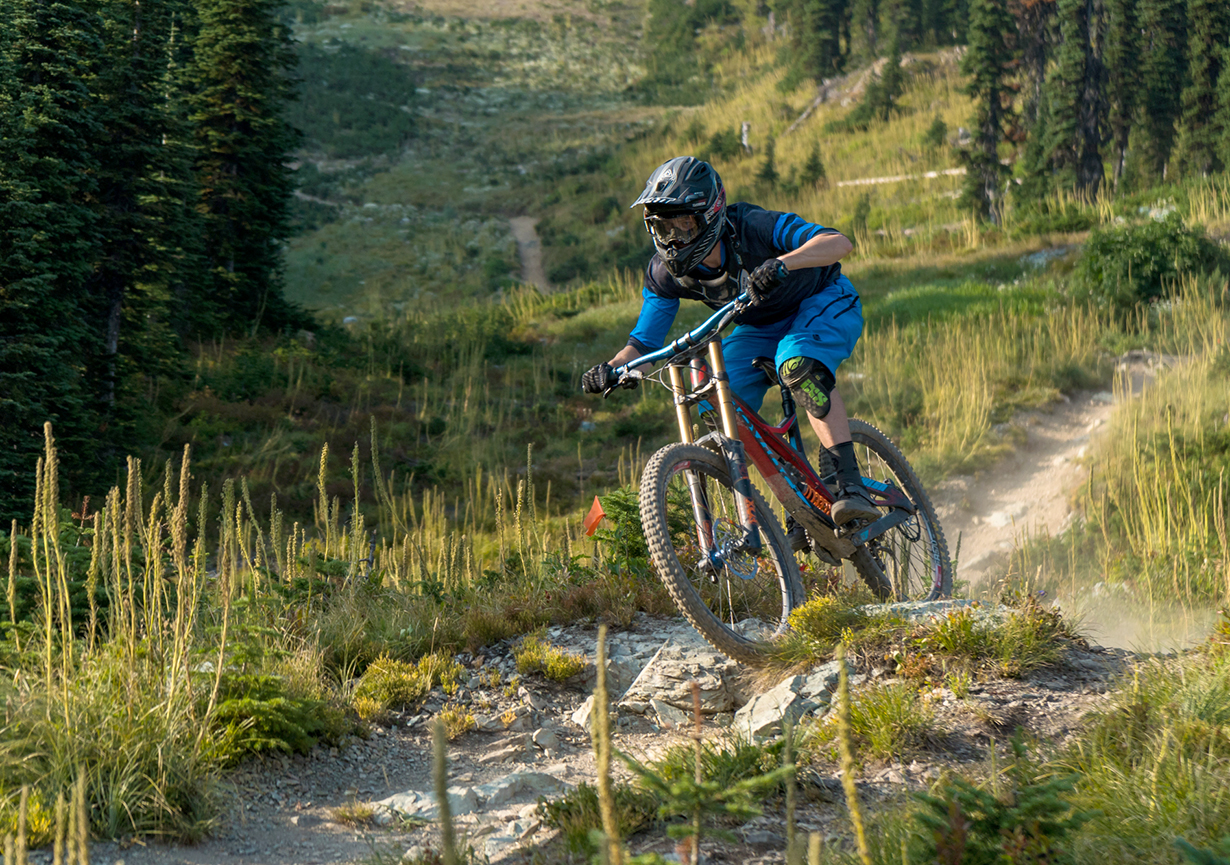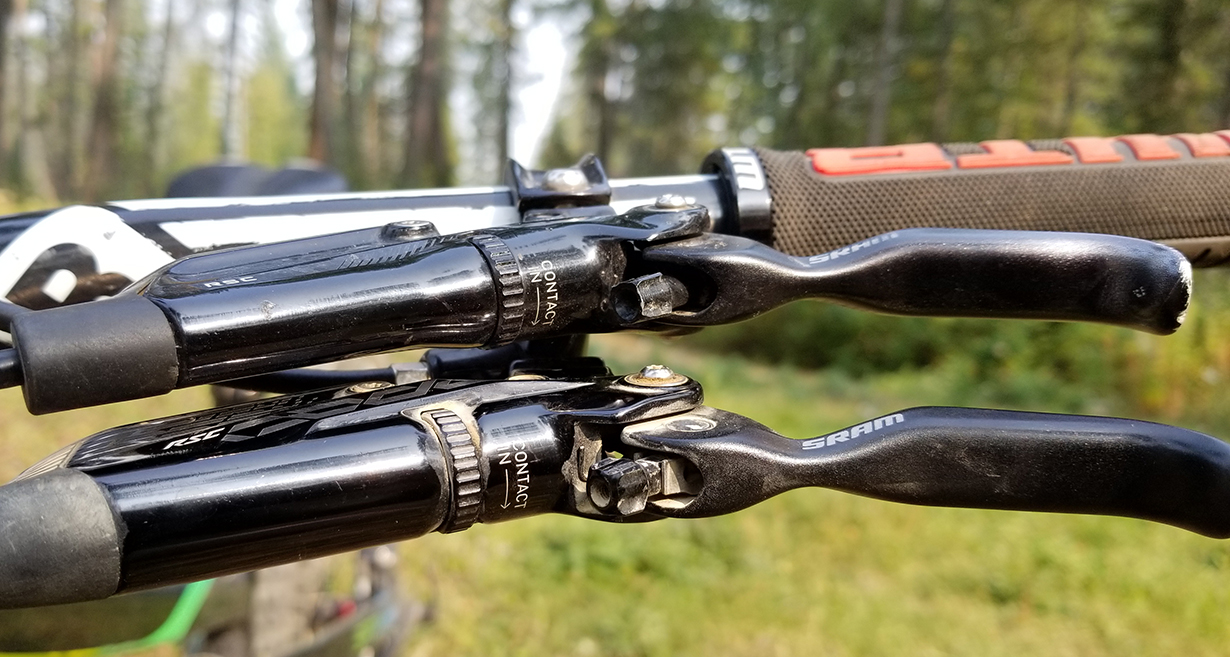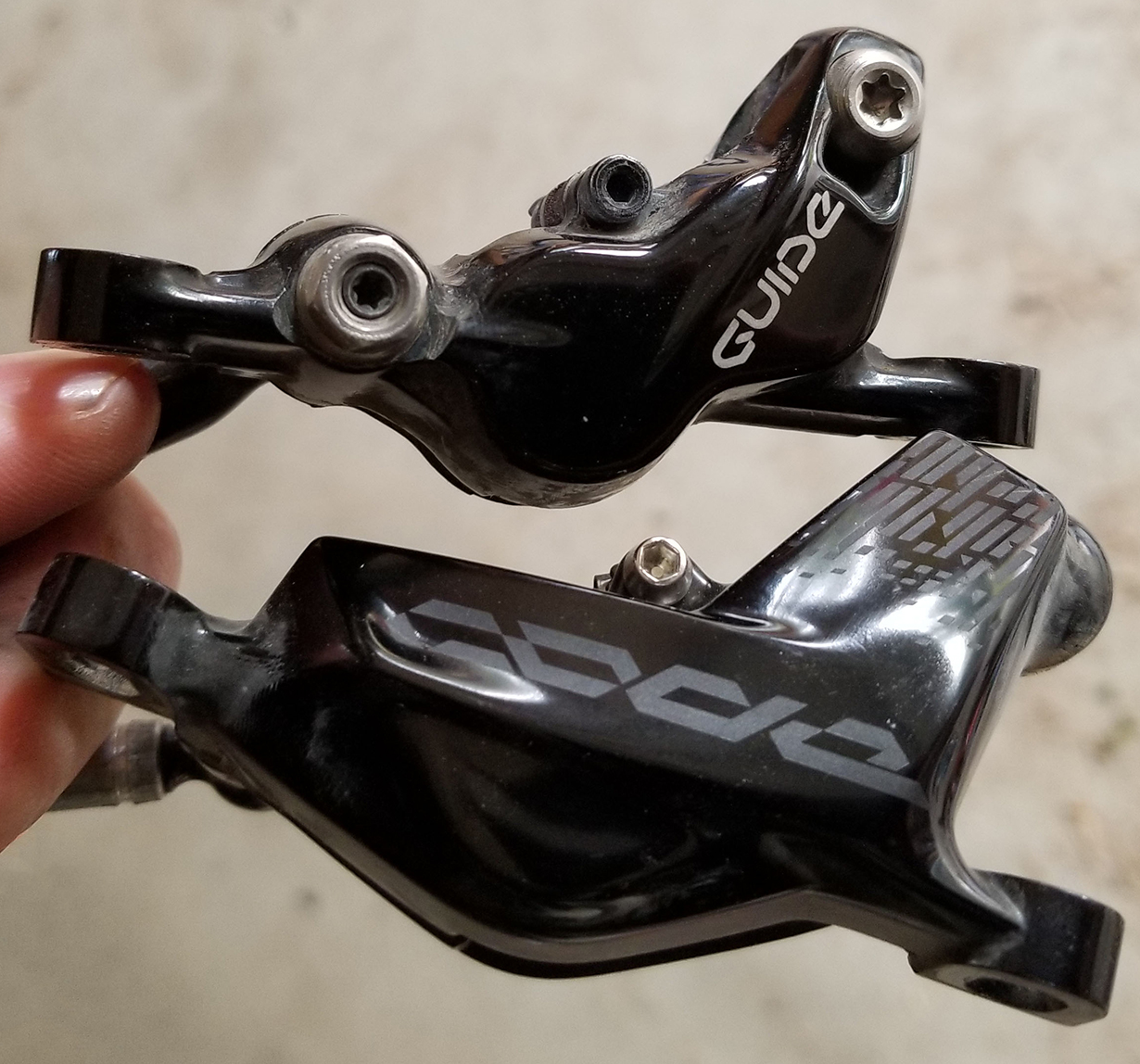
2017 SRAM Code RSC Brakes
Blister’s Measured Weight:
- Front w/ matchmaker clamp: 343 g (no adapter, no rotor)
- Rear w/ matchmaker clamp: 362 g (no adapter, no rotor)
Rotors (as tested): 200 mm Front and Rear
MSRP: $244 per brake, without rotors
Bolted to: Devinci Wilson
Rider: 5’9”, 155 lbs.
Test Locations: Montana, British Columbia
Test Duration: ~2 months
Intro
The Avid Code brakes were a staple on downhill bikes for a long time, and generally speaking, they worked pretty well. But as most of the brakes in the Avid lineup were revised and rebranded under the SRAM name, it was time for the Code brakes to get an update, too.
The new SRAM Code brakes released earlier this year represent a substantial revision from the old version. They’re still very much oriented toward DH and Enduro bikes, where big descents and hot brakes are the norm, but they have a fair amount in common with the SRAM Guide brakes that have been out for a few years now.
So are the changes over the old Code worthwhile?
Yes. So much so that I’m pretty comfortable calling these the best brakes I’ve ever ridden.

Options
The SRAM Code comes in two varieties, the Code RSC, and the Code R. Like the SRAM Guide brakes, the letters stand for the various features on the brake. So the “RSC” has a Reach adjustment, the SwingLink mechanism (which is a cam in the lever that ramps up leverage as the lever is squeezed), and a Contact point adjustment (which adjusts how far the lever moves before it starts to move the brake pads). The “R” version only has a reach adjustment, and unlike the Guide brakes, there’s no RS or Ultimate version of the Code.
What’s New And Different
We’ll start at the lever end — the lever shape and the basic adjustments are essentially the same as the Guide brakes, but the lever body itself is an entirely different beast. The master cylinder is significantly larger, so as to hold a lot more oil.

A side benefit of that extra girth is that the Code lever feels considerably more stout than a Guide lever, so I’d expect it to hold up better in a crash. Along those same lines, the lever has a built in “bend zone,” which is intended to allow the lever to bend in a crash rather than snap off, hopefully at least leaving you with a semi-functional brake to get back to the car.
The caliper end of the brake is similarly large, and this time, there’s no mistaking it for a Guide Caliper. The Code is bigger and blockier in pretty much every dimension. That extra size means bigger pistons (four of them), and a larger body with more oil volume.

The Codes also get a few less obvious features that do make a difference. Stainless steel hardware keeps things from getting rusty, and a stainless steel buffer in the caliper between the calipers and caliper body helps dissipate heat and minimizes heat transfer into the fluid. At the lever end, bearings in the pivots keep things smooth, though the Code R version misses out on that feature.
The Code also sees some of the common features among the Guide line — the levers are ambidextrous, so it’s easy to swap levers for people who are used to motos, and the levers are matchmaker compatible, so shifters and dropper levers mount up easily.
Bleeding Edge
SRAM originally released the bleeding edge system on the Guide Ultimate brakes, and it’s since trickled down to the rest of the Guide line, as well as the new Code brakes. When it first came out, I’ll admit to being extraordinarily skeptical — it just seemed like an annoyance that fixed a problem that didn’t really exist, and required me to buy a new bleed kit.
But holy shit was I wrong on that one. The bleeding edge system is a huge part of the reason that I think these brakes are the best downhill stoppers on the market.
The basic premise of the bleeding edge system isn’t too different from older Avid and Sram bleed kits — you have two syringes filled with DOT fluid attached to the lever and the caliper. You pump fluid in one end, and excess fluid along with any air comes out the other end.
The primary change with the bleeding edge system is that you can close the bleed port while the fluid filled syringe is still attached. And while that doesn’t seem like a huge deal at first, it makes all the difference.
Why does that matter? Because it lets you effectively overfill the system, which means you can set the brakes up with very little lever throw.

With older Guide brakes that didn’t have the bleeding edge system, I always found that the lever pulled a bit too far for my liking. I’d regularly run the reach and contact point adjustments as far out as they would go, and I still had to employ a few semi-questionable tricks to get the levers to engage as quickly as I wanted them to.
With the bleeding edge system and the Code RSC lever, I don’t have to do any of that. I can force a bit of extra fluid into the system, which means the levers engage really far out from the bar with very little lever travel. Then I can use the reach and contact point adjustments to dial in exactly where the levers start, and where they engage.
Just to be excessively clear, I’m writing a lot about this because I’m actually really excited about it. In twenty some-odd years of riding bikes, I’ve never ridden a pair of brakes where I could get them set exactly like I want them with so little effort. And as the pads wear and the lever doesn’t pull exactly like I want it to anymore, I’m still in the middle of the adjustment range on the contact point dial, so it’s literally a 3-second fix to get them back to perfect.
And (as I’ve been told by a lot of people) I run my brakes kind of weird and most people prefer their brakes set up differently. But the great thing about the bleeding edge system is that it’s easy to set them up however you want. The point isn’t that I can set the brakes up how I like them, the point is that without much effort, anyone can set the brakes any way they like.
On The Trail
So it’s clear that I’m excited about how the brakes can be set up and how I can get them to feel in the bike stand, but none of that does any good if they don’t get the job done on the trail. Fear not, dear reader. My Code excitement doesn’t end at the workbench.
Simply put, the Codes deliver a lot of power in an eminently usable form, and I’ve yet to notice any significant deterioration in performance from heat.

If we’re just grading brakes on all-out power, the Codes are in the same neighborhood as the Shimano Saints, with the Saints possibly having the slight edge. But the Codes modulate considerably better — where the Saint’s power comes on quite quickly, it’s much easier to ease into the power with the Codes. And I find this makes a pretty big difference in loose, steep corners where I need a bit of brake to control speed, but I also need to maintain traction. And particularly at slower speeds where a ton of braking power isn’t necessary, it’s a lot easier to get just a little bit of bite out of the Codes.
Compared to the Guides, SRAM says that the Code brakes have 15% more power, but I would have guessed it was even a bit more than that. I’ve run the Guides on my DH bike in the past, and while they get the job done, there were certainly times that I wished for a bit more power.
The Guides would also get pretty hot and start to fade a bit on bigger descents, but I haven’t had any of those issues with the Codes. On some steep descents where I’m on the brakes quite a bit, I never noticed any fade or pump from the Codes. So while I’m sure it’s possible to get them to fade, it’ll take a pretty long descent and some seriously hot brakes to get there.
To put all that another way, the Code brakes feel a lot like Guides, just with a significantly higher “max” power. So when I pull the lever just a little bit, the Code generates about the same amount of stopping power as a Guide. But as I pull a bit more, the Code’s power ramps up more quickly.
The Codes also have a firmer lever feel than the Guides — where the Guide lever can feel a little squishy at times, the Code levers are much more solid. Presumably that’s due to the beefier lever body that flexes less along with the larger master cylinder.
I’ve been running the Codes on my Devinci Wilson with 200 mm rotors front and rear, which is what I’ve always run on my DH bikes. The Codes are powerful enough that I could probably get away with going down to a 180 mm rotor for most of my riding, but it’s nice to have the bigger rotor for steeper, longer descents.
I haven’t tried the Code brakes on any Enduro-ish bikes yet, but I’d say they’re powerful enough that they might be overkill on some of the more trail oriented bikes. In other words, the Codes are fantastic anywhere that needs serious braking power, but they’re unnecessary on mellower trails. That said, this is coming from the perspective of a guy that weighs 160 lbs soaking wet. Bigger folks that are asking more from their brakes will probably be psyched on the Codes for most of their riding, and if they turn out to be a little too powerful, it’s easier to step down to a smaller rotor.
Bottom Line
Over the years, I’ve come to grips with the fact that I can’t be too picky about brakes. I can usually get any decent quality brake to be more or less how I like it, but frequently it’s kind of a hassle, and there’s almost always some degree of sacrifice.
But the SRAM Code brakes have gone and screwed that all up. The Codes offer the best feel, power, and adjustability of any brake I’ve ever ridden, and it’s ridiculously easy to get them set up exactly how I want them. Which is a bummer, because now when I go and ride other brakes, it’s a bit of a let down — my blissful ignorance has been shattered.
I’d still say the Code brakes are a bit too powerful for lighter-duty riding, but if you’re more focussed on the descents and you’re looking for some powerful stoppers, I’m of the opinion that the SRAM Code brakes are the best on the market.

SRAM brakes are great…..until the master (brake lever) pistons fail. Which they do with alarming regularity (near 100% in bike park rental fleets). Even taking a bike with current SRAM brakes out of an air conditioned building on a hot day can be enough to trigger failure (heat related piston expansion). Shimanos may come on more abruptly (Servo-Wave!!) but they’re as close to bombproof as you can get. And they’re waaay easier to bleed. And they use mineral oil instead of DOT fluid (which is nasty, nasty stuff).
Agree 1000% with above comment. SRAM is pure crap. The cheap plastic seal in the piston has poor tolerances and expands at a higher rate to heat than the piston bore and it will get stuck in extended hot down hills. This is not an isolated incident or specific to a single brake. Read the MTBR thread on guides (codes do the exact same thing) to find out how unreliable and dangerous these brakes are. Get Shimano and forget about it.
Don’t get trolled into believing the crap you read about Shimano’s being so much better than SRAM. Both are great platforms and both get the job done better than anything could have dared 10 years ago. I run SRAM RSC’s and they are heroic. I honestly cannot imagine nor want anything better. Addressing reliability and maintenance, they have been faultless from day one til today, day 400. The internet gives an unfiltered platform to every mother’s son with an agenda; just don’t miss out on a great product because some Shimmy fan-boi’s get to trash talk the competition. Peace out.